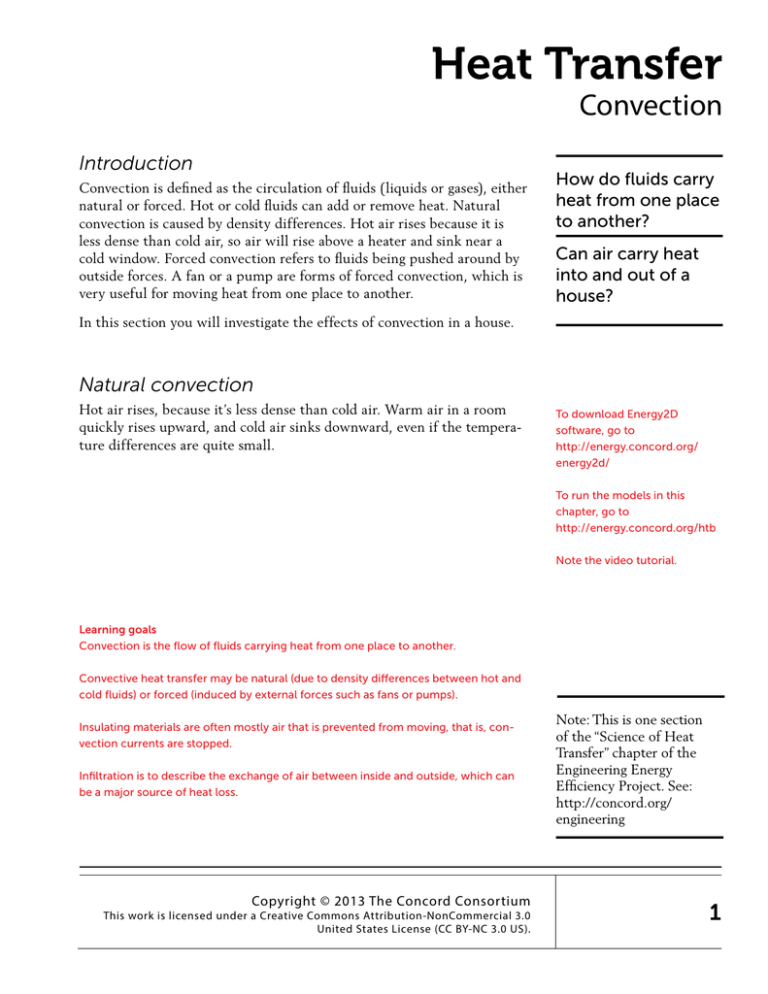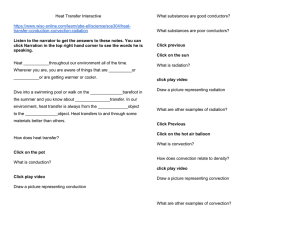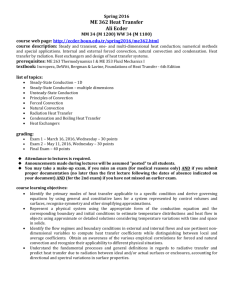2.3) Convection - Concord Consortium
advertisement

Heat Transfer Convection Introduction Convection is defined as the circulation of fluids (liquids or gases), either natural or forced. Hot or cold fluids can add or remove heat. Natural convection is caused by density differences. Hot air rises because it is less dense than cold air, so air will rise above a heater and sink near a cold window. Forced convection refers to fluids being pushed around by outside forces. A fan or a pump are forms of forced convection, which is very useful for moving heat from one place to another. How do fluids carry heat from one place to another? Can air carry heat into and out of a house? In this section you will investigate the effects of convection in a house. Natural convection Hot air rises, because it’s less dense than cold air. Warm air in a room quickly rises upward, and cold air sinks downward, even if the temperature differences are quite small. To download Energy2D software, go to http://energy.concord.org/ energy2d/ To run the models in this chapter, go to http://energy.concord.org/htb Note the video tutorial. Learning goals Convection is the flow of fluids carrying heat from one place to another. Convective heat transfer may be natural (due to density differences between hot and cold fluids) or forced (induced by external forces such as fans or pumps). Insulating materials are often mostly air that is prevented from moving, that is, convection currents are stopped. Infiltration is to describe the exchange of air between inside and outside, which can be a major source of heat loss. Copyright © 2013 The Concord Consortium This work is licensed under a Creative Commons Attribution-NonCommercial 3.0 United States License (CC BY-NC 3.0 US). Note: This is one section of the “Science of Heat Transfer” chapter of the Engineering Energy Efficiency Project. See: http://concord.org/ engineering 1 4A: Natural convection What would it be like if there were no natural convection, that is, if air didn’t move around when heated or cooled? This model compares the two situations: convection by air that is free to move and conduction through a solid with the same conductivity as air. Each is placed above a hot plate. Open Model 4A and follow the instructions, then answer the following questions. Measure top temperatures at half an hour for different bottom temperatures. Record the results of your experiments below. Results from Model 4A Bottom temperature Top temperature above air Top temperature above solid Based on the model, explain the difference between convection and conduction. Which is faster? Conduction is transfer of heat from one solid material to another through contact. Convection is the transfer of heat through flow of liquid or gas. Convection is faster, because the warm air rises very quickly and carries the heat upward much faster than it would conduct through solid stationary air (which doesn’t exist in reality). 2 Copyright © 2013 The Concord Consortium This work is licensed under a Creative Commons Attribution-NonCommercial 3.0 United States License (CC BY-NC 3.0 US). 4B: Slow down convection Suppose you could interrupt convection flow with one or more barriers. This is essentially what insulation does. Most insulation consists of tiny pockets of air separated by thin walls or fibers that stop large-scale convection. Open Model 4B and follow the instructions, then answer the following questions. How can convection in air be reduced? You can add barriers to air flow. That’s what common insulators do — wool and fur, feathers, fiberglass, foam, fiberfill, loose fill house insulation. Give two examples of natural convection in a house that you have personally observed. warm ceiling; cold floor; warmer upstairs than downstairs; heat rising from a radiator or baseboard heater (no blower); hot gases going up a chimney; water circulating in a pan on a stove Try other arrangements the slow down convection. Fill in the following chart. Condition Temperature no barrier barrier other (describe) Copyright © 2013 The Concord Consortium This work is licensed under a Creative Commons Attribution-NonCommercial 3.0 United States License (CC BY-NC 3.0 US). 3 Forced convection Be sure all students understand that moving air is not inherently colder than still air. “Wind chill” is due to a temperature difference (air that is colder than our skin) and the stripping away of the thin insulating surface layer of still air next to our skin. Forced convection refers to motion of a fluid that is not caused by differences in density between warm and cold (“hot air rises”). A fan (air) or a pump (water) is an example of forced convection. It is a very useful way to move heat around. For example, hot-air heating and air conditioning systems use large ducts to transport warm or cold air around a building. Water can also carry heat from one place to another by being pumped through pipes, that is, by forced convection. The great advantage of water is its enormous specific heat. Large amounts of heat can be transported from the boiler to all corners of the building. It is then transferred to the air in various ways. Wind chill describes the cooling effect of moving air across a warm surface, such as our skin. The cause of wind chill is simple, and it depends on the difference between conduction and convection. Air is a very good insulator, if it doesn’t move. Most good insulators – wool, foam, fiberglass – trap air in tiny pockets so that it can’t circulate. Heat conducts very slowly across each little air pocket. On the other hand, air moves very easily in larger spaces, driven by even the slightest temperature differences. When it moves, warm air carries heat from one place to another. Large air spaces in walls are not good insulation because the air moves freely and carries heat from one side to the other. Discussion question: why does putting our hand in hot or cold water feel so much hotter or colder than air of the same temperature? Picture a hot surface (such as your skin) with cold air above it. Right next to the surface is a thin layer of still air that provides some insulating value because it is not moving. Imagine what happens when you turn on a fan. Your skin cools off because the still air layer is stripped away, and the skin surface is directly exposed to the cold air. Answer: The water has a much higher heat capacity, so it warms or cools the skin much more quickly by carrying more heat. 4 Copyright © 2013 The Concord Consortium This work is licensed under a Creative Commons Attribution-NonCommercial 3.0 United States License (CC BY-NC 3.0 US). 4C: Forced convection Here’s a model that explores forced convection, the effect of wind blowing across a hot surface. Open Model 4C and follow the instructions, then answer the following questions. Record the temperatures of the upper and lower sensors after running the model for 0.4 model hours as shown on the graph (not real time) under three wind conditions. The model will stop automatically. Results from Model 4C Wind speed Temperature at upper sensor Temperature at lower sensor Low Medium Discussion question: why does putting our hand in hot or cold water feel so much hotter or colder than air of the same temperature? Answer: The water has a much higher heat capacity, so it warms or cools the skin much more quickly by carrying more heat. High Explain why the two circles have different temperatures. The wind carries heat away from the surface of the circle, so it loses heat faster than the circle with no wind. Think of other examples of the wind chill effect and how it is minimized. For animals, hair or fur cuts down on air motion near the skin. Clothes, hats, windbreakers protect skin on a cold windy day. Putting tents behind a rock in a low area for shelter from the wind. Fans increase wind chill on skin Copyright © 2013 The Concord Consortium This work is licensed under a Creative Commons Attribution-NonCommercial 3.0 United States License (CC BY-NC 3.0 US). 5 Note that in modern wellinsulated buildings, air exchange between inside and outside is so low that it must be augmented with a mechanical system so that the air stays fresh. But this is better than a “leaky” house because it is controlled. You always have fresh air, not just when the wind blows. Infiltration Introduction Infiltration refers to outside air leaking into a house. This implies that inside air is also leaking out (exfiltration), so infiltration is loosely used to describe the exchange of air between inside and outside. If the inside air is warm and the outside air is cold, lots of heat can be lost, the energy bill will increase, and the house will be drafty and uncomfortable. Infiltration can be driven by two forces: a) the “stack effect” or the “chimney effect,” where rising hot air pushes outward at the top of a building and cold air is drawn inward at the bottom; b) wind, which creates greater pressure on one side of a building than the other, and pushes air through any cracks in the building. You can explore infiltration further when you test you own model house in the section called “Modify your solar house.” 6 Copyright © 2013 The Concord Consortium This work is licensed under a Creative Commons Attribution-NonCommercial 3.0 United States License (CC BY-NC 3.0 US). 4D: Stack effect Here is a model that demonstrates the stack effect. Open Model 4D and follow the instructions, then answer the following questions. Draw the convection pattern as shown in your model after you changed the size and location of leaks in each room. Describe or use arrows to show the motion of the air. What causes more loss of energy, a leak near the ceiling, or a leak near the floor? Why? A leak near the ceiling, because hot air rises and will be lost through the leak. Copyright © 2013 The Concord Consortium This work is licensed under a Creative Commons Attribution-NonCommercial 3.0 United States License (CC BY-NC 3.0 US). 7 4E: Blowing wind This model shows a wind blowing across a building. Open Model 4E and follow the instructions, then answer the following questions. Draw the motion of the air outside the building before you open the windows. What do you notice about air motion right next to the building? In the same picture above, draw the motion of the air inside the building before you open the windows. Describe how the motion of the air changes inside the building: a. when there is a wind and the windows are open. Wind pushes air in one side and out the other. b. when there is no wind and the windows are open. Hot air rises and flows out of both windows. 8 Copyright © 2013 The Concord Consortium This work is licensed under a Creative Commons Attribution-NonCommercial 3.0 United States License (CC BY-NC 3.0 US). Connection to buildings: Convection heat loss Application There are two ways convection might cause a building to lose heat: 1. Hot air leaks out through holes in the building (infiltration driven by the stack effect). 2. Moving air lowers the surface temperature of the building (wind chill effect) and increases the heat loss from the walls and windows. It also enters the building through cracks and holes (infiltration). Suggest how you might cut down on these forms of heat loss in a real house. To cut down on infiltration, seal all of the possible holes or cracks in the house – around pipes, outlets, and basement walls. Make tighter windows and doors. Ask students: In your own house (school, classroom), do you notice any cold areas, hot areas, or unevenness of temperature? Can you explain them in terms of conduction or convection? What are the sources of heat in your rooms? How does the heat spread around? Discussion question: older houses did not have insulation – just empty air spaces inside the framed walls. Why wasn’t this fine, if air is a good insulator? Answer: the air was free to circulate inside the large wall cavities, so heat was carried by convection from the inside to the outside wall surface. Have you noticed differences in temperature between different rooms or levels in your house, or between the ceiling and the floor? Explain why in terms of conduction and convection. Different rooms on the same level: Rooms might have the following differences: Different number of windows (conduction), different insulation (conduction) more exposed exterior walls (conduction), sides more exposed to the wind (convection). Different levels: heat would rise and tend to make upper floors warmer. Cold air flows in at the lower levels, being drawn in by convection. Copyright © 2013 The Concord Consortium This work is licensed under a Creative Commons Attribution-NonCommercial 3.0 United States License (CC BY-NC 3.0 US). 9 Summary If you have time, a student could draw their diagram on the board and discuss it. Here is a cross-section of a one-room house. There is a leaky joint near the ceiling and another one near the floor. Suppose the average temperature is 40 °C inside and 20 °C outside. • D raw what you think the heat distribution might be in the house by writing temperature values in five different locations. • D raw arrows to show what you think the motion of the air might be due to convection. Now suppose the leaks were sealed up. How would it be different? • D raw what you think the distribution might be in the house by writing temperature values in five locations. • D raw arrows to show what you think the motion of the air might be due to convection. 10 Copyright © 2013 The Concord Consortium This work is licensed under a Creative Commons Attribution-NonCommercial 3.0 United States License (CC BY-NC 3.0 US).



